Movies with artificial smells in cinemas: "Behind the Great Wall" and "Scent of Mystery" |
Read more at in70mm.com The 70mm Newsletter |
| Written / compiled by: Gerhard Witte, Berlin, Germany, February 2015 | Date: 01.04.2015 |
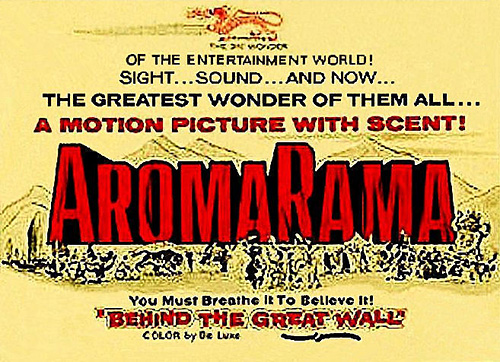 AROMARAMA
– YOU MUST BREATHE IT TO BELIEVE IT! Carlo Lizzani's documentary "Behind the
Great Wall" (La Muraglia Cinese, Italy, 1958). AROMARAMA
– YOU MUST BREATHE IT TO BELIEVE IT! Carlo Lizzani's documentary "Behind the
Great Wall" (La Muraglia Cinese, Italy, 1958)."FOR THE FIRST TIME! ... THE BAMBOO CURTAIN HAS BEEN LIFTED – offering you spectacles of a land staggering to behold!" There was a race to get smells into films at the end of 1950s between the "Smell-O-Vision!" and the "AromaRama" processes. It was won at the time by the Walter Reade Organization with a documentary called "Behind the Great Wall" (La Muraglia Cinese, Italy, 1958). "AromaRama" had been unveiled in the DeMille Theatre in New York with the movie's premiere on December 08, 1959. The process consisted of a series of 22* artificial smells (information from a movie's review written by Ira Newman) conducted through the theater's air distribution system. "Behind the Great Wall" wasn't designed with smells in mind. It was / is an existing Italian documentary that had smells added to it after the fact. *Author's comment: 37 artificial smells are given in an interesting article about the movie written in the renowned German magazine "Der Spiegel" dated January 1960. You can read it here (in German): The "Smell-O-Vision!" process debuted with Michael Todd, Jr.'s movie "Scent of Mystery" at Todd's Cinestage Theatre in Chicago on January 06, 1960. Here the smells were piped via plastic tubing to individual seats injected into the movie theatre's seats. They were triggered by the film's soundtrack and consisted of 30 different scents. From "The History of Film" written by Tim Dirks: This olfactory approach to expanding the movie-going experience actually had lesser-known precedents. A.) In 1906, rose oil permeated Forest City Pennsylvania's Family Theatre during a Rose Bowl game newsreel. B.) In 1929, lilac oil was spread through the ventilation system of a Boston theater during the opening credits of the love story "Lilac Time" (1928), and C.), in the 1940s various scents were distributed during the double-bill "The Sea Hawk" (1940) and "Boom Town" (1940) in a Detroit theater. |
More in 70mm reading: Be part of Smell-O-Vision history! A campaign to re-start Mike Todd Jr's. Smell-O-Vision for future screenings of "Holiday In Spain" Mike Todd Jr.'s "Scent of Mystery" in Smell-O-Vision “Scent of Mystery” Playdate History Internet link: Wim Wenders Foundation Review: "Behind the Great Wall" by Bosley Crowther "Scent of Mystery" by Bosley Crowther Bruce Kimmel reports on "Smelly Films" Interview: "La Muraglia Cinese" – Intervista a Carlo Lizzani Nase voll vom Film! |
Aromarama |
|
"AromaRama" debuted with the movie "Behind
the Great Wall" (La Muraglia Cinese, Italy, 1958) at New York's De Mille
Theatre on Tuesday, December 08, 1959. 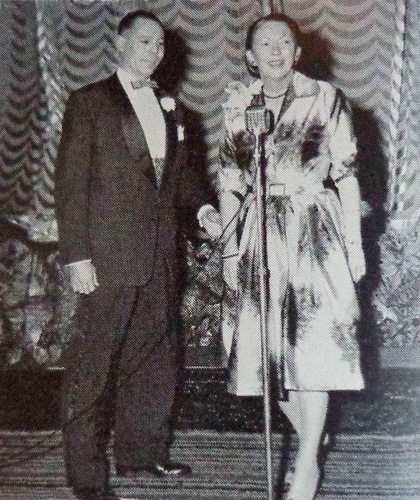 A
RENAMED THEATRE: Broadway's Mayfair has become the DeMille Theatre under the
operation of Walter Reade, Jr. – here greeting Mrs. Joseph Harper, the
daughter of the late Cecil B. DeMille at the opening of "Behind the Great
Wall" in "AromaRama". (Image from "Motion Picture Herald" dated December
1959) A
RENAMED THEATRE: Broadway's Mayfair has become the DeMille Theatre under the
operation of Walter Reade, Jr. – here greeting Mrs. Joseph Harper, the
daughter of the late Cecil B. DeMille at the opening of "Behind the Great
Wall" in "AromaRama". (Image from "Motion Picture Herald" dated December
1959) A short article written in the "Motion Picture Herald" dated November 1959: Mayfair in New York to Be Renamed for DeMille. The Mayfair Theatre in New York will be renamed the DeMille Theatre in honor of the late Cecil B. DeMille at dedication ceremonies scheduled to be held December 02* on the occasion of the world premiere of the "all scent" film, "Behind the Great Wall", in "AromaRama". It was announced by Walter Reade, Jr., whose company recently acquired a long-term lease on the theatre. Mrs. Joseph Harper, daughter of Mr. DeMille, has endorsed the renaming of the theatre in honor of her father. *Author's comment: The movie's "AromaRama" world premiere took place on Tuesday, December 08, 1959 – it debuted without smells in Italy on 29.06.1958. Short on C.B. DeMille Booked with "Great Wall". (From "New York VARIETY" dated start of December 1959) "Cavalcade of the Films of Cecil B. DeMille", a special 20-minute subject covering highlights of DeMille productions from 1913, accompanies "Behind the Great Wall" in "AromaRama" in its run at the new DeMille Theatre in New York. With narration by Henry Wilcoxon, the film features excerpts from 24 pictures, beginning with "The Squaw Man", Mr. DeMille's first, to "Ten Commandments". …and a further article written in the "Motion Picture Herald" dated Saturday, December 12, 1959: "AromaRama", adding the sense of smell to the impact of the motion picture on sight and sound, was unveiled to the public this week in connection with the opening of the new Walter Reade DeMille Theatre, the remodeled and redecorated Mayfair on Broadway. The process, which wafts scents related to the sequences on the screen into the theatre through the air ducts on cue at the projector and clears them by means of electronic precipitating filters in the exhaust duets, is used in connection with a travelogue "Behind the Great Wall". Effectiveness of the scent process was best shown in a short demonstration* in which a commentator cuts an orange. The tangy fragrance brought applause from critics. *Author's comment: The movie was shown with a newly shot introduction in which Chet Huntley talked about the "AromaRama" process, and as a demonstration he cut an orange in half and squeezed it out. The Achilles heel of signal-encoded movies with smells remains the technical application (ventilating, air conditioning, special nozzles) and the timing of the desired smells. "AromaRama" $ 126,200. (From "Motion Picture Daily" dated Monday, January 11, 1960) "Behind The Great Wall" in "AromaRama" has grossed $126,200 since its world premiere on December 09* at the DeMille Theatre here. Popular admission prices were charged at all performances in the first four weeks of the current engagement. *Author's comment: Wednesday, December 09, 1959 was the day of the movie's public premiere. "AromaRama" has its West Coast (Los Angeles) premiere: "Great Wall" to Open in L.A. on January 15. (From "Motion Picture Daily" dated Thursday, January 07, 1960) Los Angeles, Jan. 06 – "Behind the Great Wall" in "AromaRama", the motion picture with "scents" has its West Coast premiere on 15 January at the "Four Star Theatre" here. Charles Weiss, inventor of the system is presently here to supervise the installation of the special equipment and Walter Reade, Jr., chairman of the Board of Continental Distributing, which is releasing "AromaRama" internationally, will arrive prior to the meeting for a series of press interviews. A planned second "AromaRama" movie: (From "Motion Picture Daily" dated Wednesday, January 13, 1960) Hollywood, Jan. 12 – "A Scent of New Mown Hay", the second film in "AromaRama", will be produced by Aubrey Schenk and directed by Howard Koch for the Continental Distribution Corp., Walter Reade, Jr., chairman of the Board of Continental, announced today. Reade said he is negotiating with Laurence Harvey to play the lead in the new production which will be the first "AromaRama" process to receive detailed story treatment. "Behind the Great Wall", the first "AromaRama" picture, will open here Friday, at the "Four Star Theatre". It premiered at the DeMille Theatre in New York last month. Author's comment: Information about the successful novel "A Scent of New Mown Hay" written by John Blackburn (1923-1993): The "AromaRama" movie was unfortunately not realized. An Extract from the “Boxoffice” magazine dated January 18, 1960. "Discussing the installation problems for exhibitors who intend to show "AromaRama" projects, Reade said that the initial costs were approximately $3,500 but that they had been reduced now to $2,500 and the company is currently making a pilot installation in upper New York at the latter cost. He visualizes costs going considerably downward in the future, exemplifying with the initial $1,800 installation costs of 3D that finally went down to $500. There are only five installations to date. Beyond installation costs, the exhibition will experience varied costs for the fragrances exuded during showings. In the case of the “Four Star Theatre” here, he said, the costs will be approximately $11 per performance, with four performances daily." |
|
Three Reviews published at the time of the movie's premiere |
|
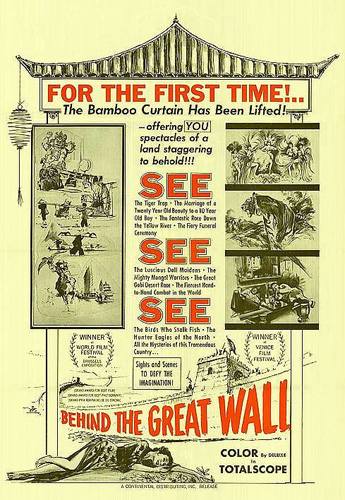 One
of the movie's posters – here presented without "AromaRama" equipment/smells.
Poster captions: One
of the movie's posters – here presented without "AromaRama" equipment/smells.
Poster captions:SEE: The Tiger Trap + The Marriage of a Twenty Year Old Beauty to a 10 Year Old Boy + The Fantastic Race Down the Yellow River + The Fiery Funeral Ceremony. SEE: The Luscious Doll Maidens + The Mighty Mongol Warriors + The Great Gobi Desert + The Fiercest Hand-to-Hand Combat in the World. SEE: The Birds Who Stalk Fish + The Hunter Eagles Of the North + All the Mysteries of this Tremendous Country. Sights and Scenes - TO DEFY THE IMAGINATION! Winner at World Film Festival at the Brussels Exposition / Winner at Venice Film Festival. (Color by DeLuxe in TotalScope) "New York VARIETY " dated Wednesday, December 16, 1959) Behind the Great Wall in "AromaRama". A Continental Distributing Release of an Astra Cinematografica / Leonardo Bonzi Production directed by Carlo Lizzani. The "AromaRama" process was conceived and directed by Charles Weiss, written and adapted for "AromaRama" by Sidney Kaufman and Thomas Orchard. Narrator: Chet Huntley / Camera (DeLuxe Color): Pier Ludovico Pavoni / Editor: Mario Serandrei / "AromaRama" Editor: Lou Rothstein / Music: Angelo Francesco Lavagnino. Reviewed at the DeMille Theatre, New York, Dec. 8, 1959. Running time 97 minutes. A feature-length documentary focusing on Red China, made by Italian producer Leonardo Bonzi a few years ago, "Behind the Great Wall" beckons trade attention now for it is being used to introduce "AromaRama". The film unveiled (or uncorked?) New York's refurbished Mayfair, now the DeMille Theatre. The prologue makes a comparison of this scent-yielding process with such cinematic milestones as sound, color and widescreen, and this simply is unrealistic; there's no new screen dimension added, such as provided by CINERAMA. But the immodesty can be forgiven, for the presentation in good part does live up to its "you-must-breathe-it-to believe-it" promises. Effective smells permeate the theatre, as emitted through air-conditioning ducts, and are synchronized with the screen goings-on with remarkable precision. Net result is a travelogue with a good commercial one-shot gimmick. Opening is a talk by commentator Chet Huntley, reminiscent of Lowell Thomas introducing "This is Cinerama". And thereupon the public gets a view of a bowl of oranges, the halving and squeezing of one of them, and along with this the unmistakable aromatic pleasure of an honest-to-goodness orange. From this point the audience is invited to poke its nose sniffing into modern China. The documentary on its own is interesting, if somewhat uneven in terms of continuity. It copped the "best film" and "best photography" awards at a Brussels Film Exposition. This nasal-sprayed adaptation, as being put on by circuit operator-film importer Walter Reade, perhaps left out a scene here and there with the view of concentrating on the footage that especially lent itself to "AromaRama". The tour behind China's Great Wall provides cues for the transmission of numerous smells, ranging from the offensive waterfront, to the most agreeable grazing land, to sharp spices to the varying sweetness of jasmine and incense. Indeed, there's an over-abundance of different smells, with many of them undiscernible to the average person, and this becomes disconcerting. Too, there are instances where the machine-made olfactory flavors don´t correspond with what's on view. Interesting is the rapid removal of one aroma from the theatre to make way for another, as engineered with a purification air flow. However, there's a bargain-basement perfume fragrance that is injected frequently and gets too darn persistent. This has got to go. There's no new screen dimension within the milestone frame of reference in "AromaRama". It's hardly likely to remain a part of the picture business scene, on the basis of this first exposure (perhaps Mike Todd Jr.'s upcoming "Smell-O-Vision!" may enhance the chemistry to a more significant cinematic level). But there's a lot of built-in talk-about in "Behind the Great Wall" as a single entity – enough to assure a nice payoff for the Reade company. (Gene.) Author's comment: The movie had been shot in TotalScope, an Italian film industry's version of CinemaScope with an aspect ratio of 2.35:1 and was also presented in stereophonic sound in some theatres. |
|
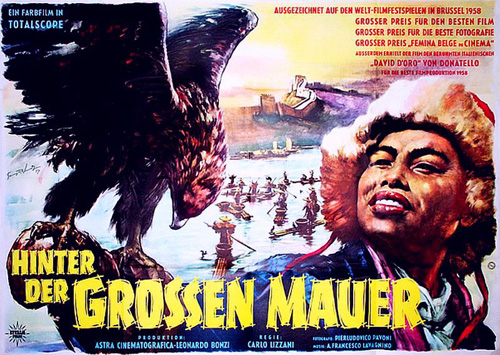 The
German poster of the movie "Hinter der großen Mauer" (Behind the Great Wall,
La Muraglia Cinese, Italy, 1958). A 35mm color film in TotalScope.
Distributor: Stella Film. The West German premiere of the movie took place
at the "Filmbühne Wien" located on Berlin's Kurfürstendamm on September 24,
1959. Poster captions: The
German poster of the movie "Hinter der großen Mauer" (Behind the Great Wall,
La Muraglia Cinese, Italy, 1958). A 35mm color film in TotalScope.
Distributor: Stella Film. The West German premiere of the movie took place
at the "Filmbühne Wien" located on Berlin's Kurfürstendamm on September 24,
1959. Poster captions:The movie was awarded at the World Film Festival in Brussels in 1958: Grand Prize Award "Best Movie" / Grand Prize Award "Best Photography" / The Award "Femina Belge du Cinema" and also the famous Italian "David d´oro" by David di Donatello for the best Film Production in 1958. New York's University newspaper "Columbia Daily Spectator" dated Monday, February 08, 1960) SMELLING THE MOVIES written by Ira Newman. Faced with the competition of television, the movie industry has tried a number of daring experiments in the past decade: 3D, widescreen, stereophonic sound. Now a new device – the addition of a "scent track" dubbed "AromaRama" is being unveiled at the DeMille Theatre in a documentary on China called "Behind the Great Wall". The process consists of introducing a series of artificial smells through the theater's air distribution system, which are intended to simulate scents associated with the filmed scenes. The aromas are scattered throughout the film and are identified by means of subtitles superimposed on the screen. "Behind the Great Wall", which runs about an hour and a half, contains twenty-two smells, each lasting about one minute. The new device will undoubtedly have wide acceptance as a spectacular stunt and, consequently, should enjoy success for a while in any case. But the real question among serious movie-goers is whether and how the scent track can be used to advance the cinema as an art form and medium for information. A good number of people have probably passed the device off as a novelty lacking real value, on the grounds that smell is not an "intellectual sense." They go to the movie, anticipating something on the order of a Coney Island side show or another Hollywood gimmick – and nothing more. This is a narrow attitude. Such a viewpoint a half century ago, when movies were first being developed, would have finished the cinema before it had a chance to prove itself. I do not think it inconceivable to think of using the scent track as a dramatic background device. It could add a new dimension to the relating of moods to an audience. A decaying Southern mansion in a Faulkner story, the joys of a Tom Sawyer, or the harsh effects of industry will have greater immediacy when they are represented by scents in the same way that musical relationships connote certain moods. In the documentary film, accurate reproductions of the aromas of a place could add to its realism and informational value. But to gain satisfactory effects, the scent track must be used cautiously. Aromas play only a subordinate role to the other components of a film. If they are of poor quality or if the scent track is overemphasized, the result will be nothing but cheap sensationalism. After seeing "Behind the Great Wall", it becomes apparent that a great deal must still be done to perfect the technique. The main disappointment of "AromaRama" is its inability to capture the subtle nuances of an area's smell. The pure aroma of foods and spices was represented as the smell of a Hong Kong street, although a bus spouting gas fumes passes directly before the camera. It also seemed that many of the smells were repeated again and again, although the localities associated with them were different. As a documentary, "Behind the Great Wall" is well constructed and extremely interesting. Narrated by television newscaster Chet Huntley, the film shows the revolution taking place today in Red China. Through color and stereophonic sound we see first the exotic "old" China: The tiger hunt, Buddhist rites, falcon hunting, and the funeral pyre for a drowned child, and then highlights of the new, Communist-variety China, including an extract from a Communist propaganda film, scenes depicting collective labor and an elaborate parade. The film has already won Grand Prize Awards at the 1958 Brussels Festival as best film and best photographed, and will probably be high in the running for American honors this year. Author's comment: In Austria (Vienna) the movie premiered at the "Urania" cinema on December 21, 1959 – here and in Germany without "AromaRama" equipment/smells. |
|
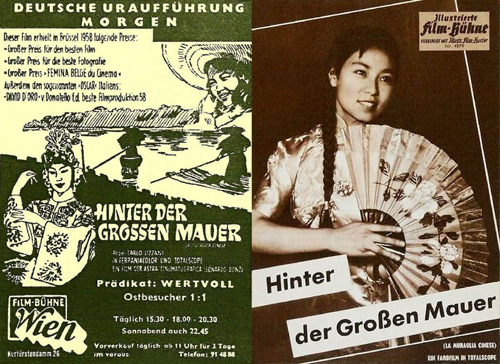 Advert
"Hinter der großen Mauer" in a Berlin newspaper dated September 23, 1959 for
the movie's German premiere at the "Filmbühne Wien" on the following day,
and the German programme. (From the author's collection) Advert
"Hinter der großen Mauer" in a Berlin newspaper dated September 23, 1959 for
the movie's German premiere at the "Filmbühne Wien" on the following day,
and the German programme. (From the author's collection)A film review taken from the German trade magazine "Filmwoche" dated Saturday, November 07, 1959: Let us take a look behind the Chinese bamboo curtain in order to get a glimpse into the life and goings-on of a people numbering millions upon millions, about which up until now we did not know very much about. The Italians – we have to give them credit – are masters of such expeditions. They have already given us extreme insight many times over into different parts of the Earth. In this regard, this film is also a success. The variety of the impressions that assail the viewer is hard to believe. From Hong Kong, the trip goes first into the deepest of the southern region, and then into the far north. There, rare encounters are shown; for example, a rousing tiger hunt, a massive flood disaster, and the frustrating life of a young girl who will be married at twenty years of age to a ten-year-old boy. It goes into the mountains and to Shanghai. It is unfortunate that the film does not even once show a more accurate map overview so that one would know where things were actually taking place. If one also dispenses with any political overtones, one can still get a more exact view of the China of these years. Pier Ludovico Pavoni and Alessandro D'Eva's cameras have glimpsed over the "fence" under the direction of Carlo Lizzani. They recorded scenes of mass gatherings (at the end of the Festival of the Millions in the capital city, Beijing) better than they could be re-enacted in any feature film. The colors (Ferraniacolor) here are perfectly executed! Stereo sound and a soundtrack that is fitting to the film, as well as TotalScope round out the impression perfectly. The film, already awarded many prizes, would have to make a lot of money in Germany, because it is not the sort of thing you see every day! German-language commentary: Dr. Rolf Tasna. The movie was rated "valuable" by the German Film Rating Commission. |
|
Smell-O-Vision |
|
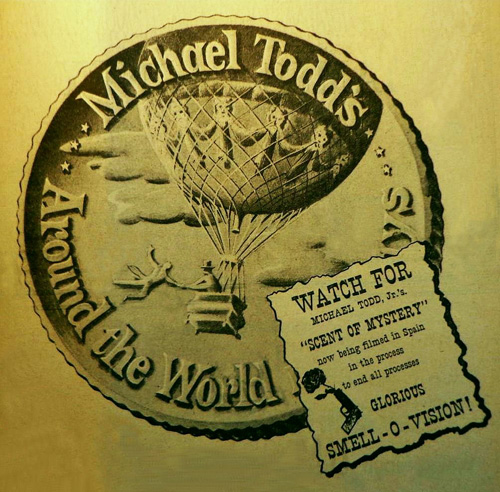 An
advert announcing the movie "Scent of Mystery": Watch for Michael Todd,
Jr.'s "Scent of Mystery" now being filmed in Spain in the process to end all
processes "Glorious Smell-O-Vision!"(Advert from “New York VARIETY” dated
Saturday, June 06, 1959) An
advert announcing the movie "Scent of Mystery": Watch for Michael Todd,
Jr.'s "Scent of Mystery" now being filmed in Spain in the process to end all
processes "Glorious Smell-O-Vision!"(Advert from “New York VARIETY” dated
Saturday, June 06, 1959) "Smell-O-Vision", this new smell process was first presented to the public at the world premiere of Michael Todd, Jr.'s movie "Scent of Mystery" (USA, 1960) in his "New Todd Process" filmed with a newly developed Todd Process Camera. The premiere was held at his impressive Todd's Cinestage Theatre in Chicago on Wednesday, January 06, 1960. I would like to highly recommend that you read the excellent report from David Coles' "Scent of Mystery: Playdate History". World Premiere in Chicago: (From "Motion Picture Daily" dated Wednesday, January 06, 1960) Chicago, Jan. 05 (the day before the premiere) – The world premiere of Michael Todd, Jr.'s "Scent of Mystery"– the first film in the "Smell-O-Vision!" process – will be held here tomorrow night at the Cinestage Theatre. The $2,000,000 comedy-mystery was filmed with the new Todd Process Camera on 70mm color film and is the first motion picture to use eight-channel sound. Author's comment: The so-called "Todd-Belock 8-channel sound system". Smell-O-Vision! Bows Tonight in Chicago. Todd and Elizabeth Taylor are sponsors of the premiere. They will participate in tonight's festivities, which include open air entertainment on the stage under the marquee of the Cinestage Theatre before showing and supper at the Ambassador Hotel after the show. Stars of stage, screen and television will attend the supper. 30 Smells Detected at Smell-O-Vision! Bow. (From "Motion Picture Daily" dated Thursday, January 07, 1960) Chicago, Jan 06 – The scent of the industry's first film in "Smell-O-Vision!" Michael Todd, Jr.'s "Scent of Mystery", tonight attracted hundreds of industry performers and financial leaders, in addition to a battery of press personnel recruited from around the country. Sponsored by Todd and Elizabeth Taylor, the premiere was held tonight at the Cinestage Theatre, which had been converted to accommodate the new aromatic process. The $2,000,000 mystery-comedy, made completely on location in Spain, was filmed in the Todd process on 70mm film synchronizing scents with action on the screen. Thirty different smells were projected to each seat in scenes where olfaction is vital to the plot or important clues in solving the mystery. Whiffs gags, using smells to tell a joke, were also introduced in the production. The Swiss osmologist Hans Laube is the inventor of the process controlled by Todd exclusively. |
|
The Movie in New York: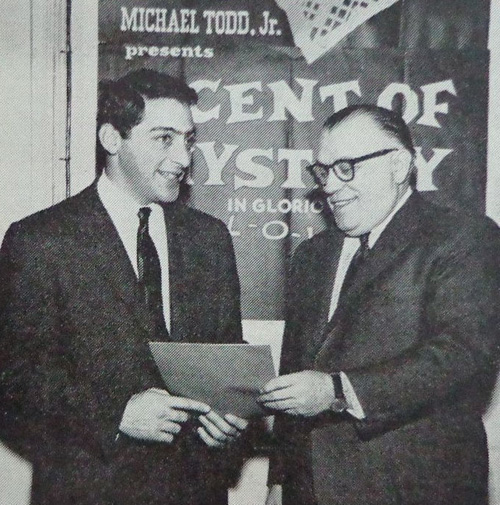 SMELLS
SIGNED: Michael Todd, Jr., left, and Harry Kalmine sign contract for the
"Smell-O-Vision!" movie "Scent of Mystery" to play at the Warner Theatre,
New York. Installation of the special scent equipment at the Broadway house
has begun. (Image from "Motion Picture Herald" dated January 1960) SMELLS
SIGNED: Michael Todd, Jr., left, and Harry Kalmine sign contract for the
"Smell-O-Vision!" movie "Scent of Mystery" to play at the Warner Theatre,
New York. Installation of the special scent equipment at the Broadway house
has begun. (Image from "Motion Picture Herald" dated January 1960)What's Sniffing In Smells War? (From "New York VARIETY" dated Wednesday, December 02, 1959) Installation of "Smell-O-Vision!", Michael Todd, Jr.'s new aroma process, will cost approximately $15,000 a theatre once all the bugs are ironed out. It's figured that the cost of the initial situation, Todd's Cinestage Theatre in Chicago, will run somewhat higher because of the experimental nature of the tee-off outlet. With theatres lined up in Chicago, Los Angeles and Boston for the showing of "Scent of Mystery", young Todd is still on the prowl for a Broadway installation. He had his eye on the Rivoli Theatre, where his late father successfully unveiled "Around the World in 80 Days", but was told he could only have the theatre until April or May because 20th- Fox's "Can-Can" is committed to play the house. Todd not only wants a house for which he can make at least a year's deal, but also requires one that has a wide screen and equipment capable of presenting the film in the Todd-AO process with eight-channel stereophonic sound. The theatres that have been employed for hard-ticket engagements are, of course, most suitable for Todd's purpose. The Warner Theatre on Broadway would be ideal, but the availability of the house depends on the length of the run of Samuel Goldwyn's "Porgy and Bess". The Los Angeles unveiling will be at the Ritz Theatre on January 27*, 1960. The installation has started at the Coast house. In Boston, the Smell-O-Vision picture is set for Ben Sack's Capri Theatre, but no date has been scheduled. *Author's comment: The movie's Los Angeles premiere took place on Monday, January 25, 1960 Todd's "Smell-O-Vision!" (From "Motion Picture Daily" dated Wednesday, January 13, 1960) Michael Todd, Jr.'s "Scent of Mystery" the first film in "Smell-O-Vision!" has exclusively been booked into the Warner Theatre here beginning February 03* on a road-show basis, it was learned yesterday. It will follow "Porgy and Bess", now in its seventh month at the Warner. *Author's comment: The movie's premiere at the Warner Theatre in New York took place on Thursday, February 18, 1960. "Smell-O-Vision" has its West Coast (Los Angeles) Premiere: "Scent" Slated this Year in 12 Cities, says Todd. (From "Motion Picture Daily" dated Friday, January 22, 1960, written by Samuel D. Berns) Los Angeles, Jan. 21 – "Scent of Mystery" Michael Todd, Jr.'s initial production in the new "Smell-O-Vision!" process, will be playing in over 12 cities and in several foreign countries by the end of 1960, the son of the late showman announced at a press conference held at the Hollywood Gourmet. The conference also served to introduce Hans Laube, the Swiss inventor of the "Smell-O-Vision!" system, who is in Los Angeles to supervise all alterations and equipment installations at the Ritz Theatre, where it will have its West Coast premiere on Monday, January 25, 1960. Todd stated that the system is not compatible with "AromaRama" and the "Smell-O-Vision!" installation costs of approximately $35,000* are not shared by the exhibitor. *Author's comment: Yes, in the article is written $35,000. If that is correct the installation costs have considerably increased from the about initial $15,000. |
|
Two Reviews published at the time of the movie's premiere |
|
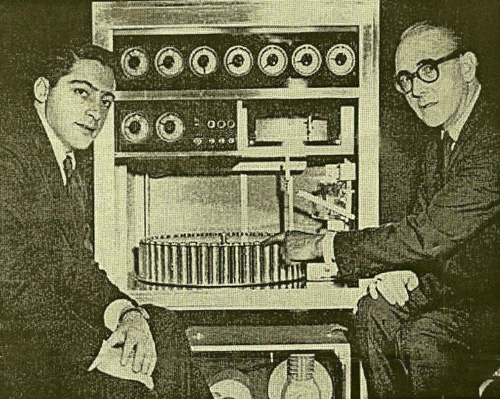 The
brains of "Smell-O-Vision!" – Michael Todd, Jr. (left) sits beside master
control and scent energizer of the "Smell-O-Vision!" system with its
inventor Hans Laube. Latter points to the multitude of vials each containing
a different scent which is selectively projected through tubes to every seat
in theatre on signal triggered from picture's sound track. (Image from the
author's collection) The
brains of "Smell-O-Vision!" – Michael Todd, Jr. (left) sits beside master
control and scent energizer of the "Smell-O-Vision!" system with its
inventor Hans Laube. Latter points to the multitude of vials each containing
a different scent which is selectively projected through tubes to every seat
in theatre on signal triggered from picture's sound track. (Image from the
author's collection) "New York VARIETY" dated January 1960. Chicago, Jan. 12 / "Scent of Mystery" – diverting tale told with nostril-appeal, the smell cycle's second-comer. Okay gimmicks. The movie premiered at the Cinestage Theatre, Chicago, on Wednesday, January 06, 1960. Runtime 125 minutes. Now that the second "smelly" process, "Smell-O-Vision!" has been "uncorked", it appears that the new dimension will be nothing more than a passing whiff. Except for providing a novelty value, the accompanying smells neither add nor detract to the basic enjoyment of a motion picture. Fortunately, for Michael Todd, Jr., who unveiled "Scent of Mystery" at his Cinestage Theatre in Chicago, he has a diverting and entertaining mystery-chase picture that can stand on its own without smells. The aromas provide the plus that gives the film an aura of importance and oddball-ness that can be exploited successfully for roadshow engagements. The offering, however, rates as a solid box office attraction for general situations sans "Smell-O-Vision!". "Scent of Mystery" has been carefully planned to synchronize scents with action in the film. Unlike "AromaRama", which hit the market (in Manhattan) first, the "Scent of Mystery" script, written by William Roos, has been designed with the smells in mind. In the "AromaRama" presentation, a documentary dealing with Red China, the smells were added as an afterthought. The dispensing systems are different. In "Smell-O-Vision!", developed by the Swiss-born Hans Laube, the smells are piped via plastic tubing – a mile of tubing at the Cinestage Theatre – to individual seats, the scents being triggered automatically by signals on the film's soundtrack. The "AromaRama" smells are similarly touched off, but are conveyed through the theatre's regular air ventilating system. The "Smell-O-Vision!" smells seemed more distinct and recognizable and did not appear to linger as long as those in "AromaRama". Reaction of those at the "Smell-O-Vision!" premiere was mixed. Of those queried, not all claimed to have whiffed the some 30 olfaction said to have been distributed during the course of the film. A number of balcony smellers said the aroma reached them a few seconds after the action on the screen. Other balcony dwellers said they heard a hissing sound that tipped off the arrival of a smell. Among the smells that clicked were those involving flowers, the perfume of the mystery girl in the film, tobacco, orange, shoe polish, port wine (when a man is crushed to death by falling casks), baked bread, coffee, lavender and peppermint. The picture has not only been tailored to employ smells, but has also been geared specifically for the 70mm widescreen. As such, it can serve as an example to CINERAMA as to how a story-line film can be shot in the king-sized process. Utilizing the Todd Process, a similar but technically different process than Todd-AO, the picture – with or without the smells – is a fun picture, expertly directed by Jack Cardiff. It has many elements that are derivative of a Hitchcock chase film, the late Mike Todd's "Around the World in 80 Days" and the CINERAMA travelogue technique. It wanders all over the Spanish landscape, covering fiestas, the running of the bull's ceremony, native dances, street scenes of Spanish cities and towns. It is often breathtaking in its scenic splendor and will serve as a great assist for Spanish tourism. The travelogue is neatly integrated as part of the chase as Denholm Elliott, as a very proper Englishman on Spanish holiday, plays a sort of Don Quixote character who boldly stumbles through the cities and countryside as a self-appointed protector of a damsel in distress. He is accompanied by a philosophical taxi driver, neatly portrayed by Peter Lorre. Paul Lukas is properly sinister as a mysterious hired assassin. Beverly Bentley is fine as blonde decoy, Leo McKern as a bullfight-happy pension keeper, Mary Laura Wood as his "black-hearted" wife, and Peter Arne as a villainous lawyer. Elliot turns in a winning performance as the bumbling but brave Englishman. Cardiff has wisely directed the film with a tongue-in-cheek quality that is reminiscent of the style of "Around the World in 80 Days". Diana Dors is seen briefly on a Spanish beach and Elizabeth Taylor is present at the denouement in a non-speaking role. Although smell plays an important part in Elliott's uncovering of the villain, the audience need not necessarily be involved in the smell – the recognition of a man's tobacco. John von Kotze's photography is superb as it captures the scenes of numerous Spanish cities and the surrounding countryside. All other technical aspects are first-rate. The new Todd process gives the same effect as Todd-AO, although there are occasions when blurring is apparent. One can quarrel with the constant repetition of the road scenes as car chases car or follows car, but overall it's worth the ride. (Holl.) |
|
|
"Motion Picture Herald" dated Saturday,
January 16, 1960). Scent of Mystery (125 minutes), reviewed at Todd's Cinestage Theatre in Chicago. Reviewer: Saul Ostrove – his Rating: Very Good. Michael Todd, Jr. – New process (Todd Color – Camera 70 – Smell-O-Vision) Michael Todd, Jr.'s infant of the motion picture and chemical laboratories, "Smell-O-Vision!" marks a curious point of departure for the industry. With a Todd seal on it, "Scent of Mystery" likely will sell as heavily as it smells, but beyond this film, which is the first one to employ scents intrinsic to the story told on the screen, it is difficult to determine how secure a market the process will establish. "Scent of Mystery" is a lot of fun. It is fresh and vast and cleverly done. It offers thrills directed so that the viewer feels he personally is making a discovery each time his whiff is true. Therefore, he is at once flattered and amused up to 30 times during the motion picture. The smells are many and varied. They range from roses to mules, with literally a grab bag of olfaction spilled down the ladder of scent – bananas, gasoline, onions, coffee, wood, bread, tobacco, assorted cosmetics and the "Scent of Mystery" itself, a fragrant perfume. The effects of the smells in the theatre are almost as varied as the smells themselves. Many are subtle, others so subtle that a viewer with a less sensitive scent is bound to miss them. Many are powerful, others so pungent they are embarrassing; these smack the viewer right across his nose and occasionally cause his eyes to tear. "Scent of Mystery" is a comedy-mystery broad in all its avenues. Its color and photography are spectacular, indicating the grand virtue of location shooting, in this instance, in Spain. Many scenes are truly breathtaking, notably those in which John von Kotze's cameras patiently pan the magnificent Spanish countryside and coastal plains. The bull-rushing scenes shot in Pamplona are as hearty and colorful as anything similar done before in motion picture. The cameras also obtain stark and beautiful effects from the air which further intensify the action. Not to be overlooked is the use of eight-channel sound, a process that allows pinpoint oral timing on the screen, as natural as dialogue emanating from the live stage. Directed by Jack Cardiff, "Scent of Mystery" stars Denholm Elliott, Paul Lukas, Peter Lorre, Beverly Bentley and Diana Doors. They perform pleasantly and they seem to be having a happy time. Some of the moments are slapstick in their departure from William Ross` script. Evil abounds, all right, but it is a giddy sort of evil. Elliott is an English tourist in Spain, Lorre his native cab driver, advisor and confidant. Lukas is engagingly sinister villain and Miss Bentley, blonde and cleanly attractive, the go-between for a group determined to murder a young, prospective heiress. The desserts are just and Elliott, that fortunate bloke, winds up with a young woman far more beautiful than he would have supposed - Elizabeth Taylor - in a delightful turn of events that is as pleasing to the audience as it is to the hero. The film is big and bright enough to do without smells, although these do count in the run toward justice and, fortunately, the scents do not distract from the film's other good elements. "Smell-O-Vision!" does not present all there is to smell. Rather, it is selective, using for the most part pleasant aromas chosen not at random but through a thorough web of design, and leading to important questions to be answered as the scent process begins to achieve maturity: What smells should be used? - All of them? - Or only those which are pleasing? - Or some which are heavy and offensive but important and challenging? Todd wisely has been cautious. He evidently is content to let his audiences smell out the problem for him and, in "Scent of Mystery" he has taken an important step in the construction of what could become the industry's biggest bridge in many years. |
|
Author's Comment |
|
|
The short movie "Arisha, the Bear and the
Stone Ring" (29 minutes), made by Wim Wenders, the renowned German film
producer, was presented at the Tokyo International Film Festival on December
21, 1992. The film was commissioned by a Japanese car museum. There you
could see the film with six smells (!), sitting on car seats that would tilt
in corners and shake on cobble stone pavement. (Info from the web site of
the Wim Wenders
Foundation). In some movie reviews the word "odor" was used at the
time. I deleted it and wrote "smell". Today the meaning of the word "odor"
is not positive. It describes an "unpleasant smell", whereas "smell" is neutral. |
|
| Go: back - top - back issues - news index Updated 22-01-25 |
